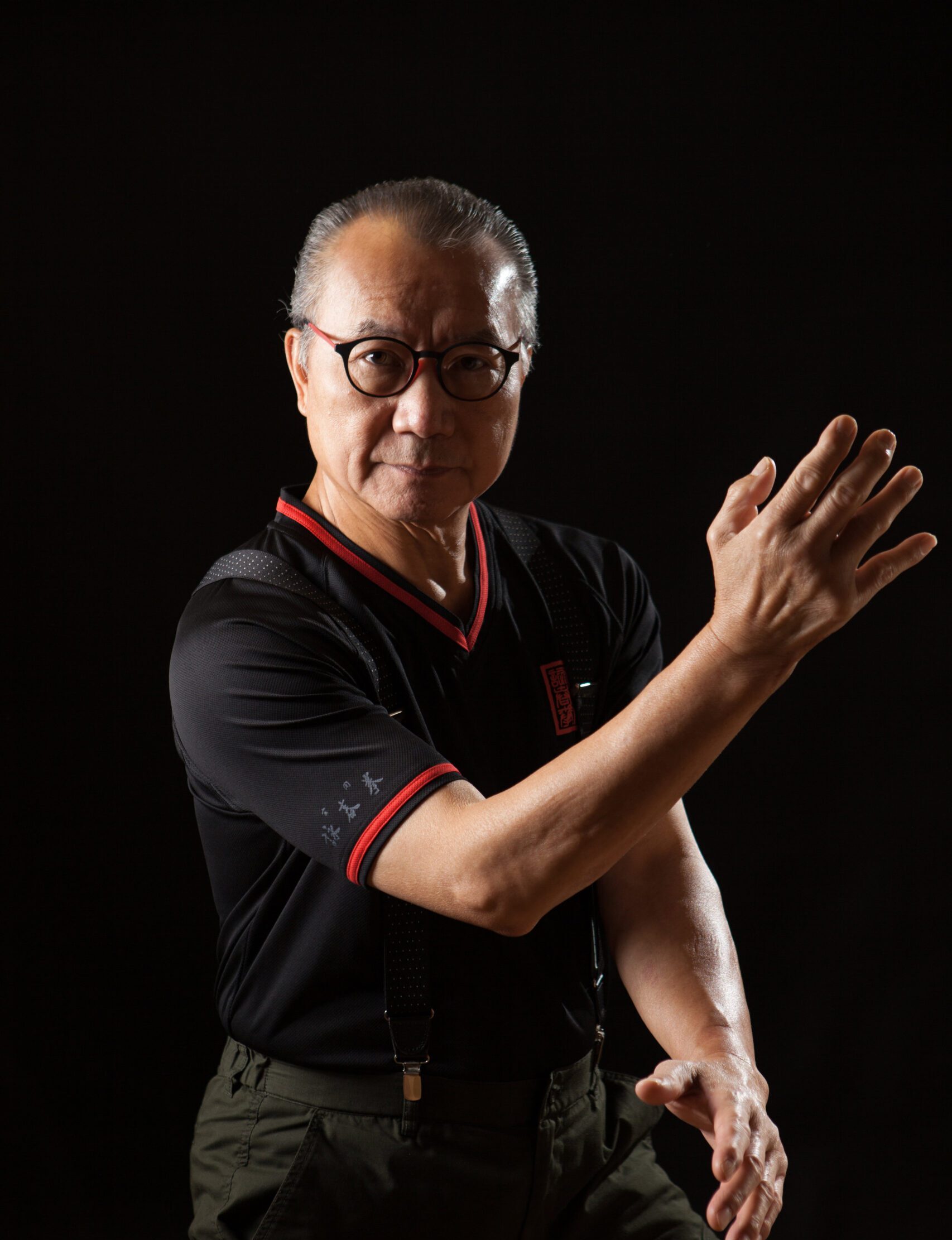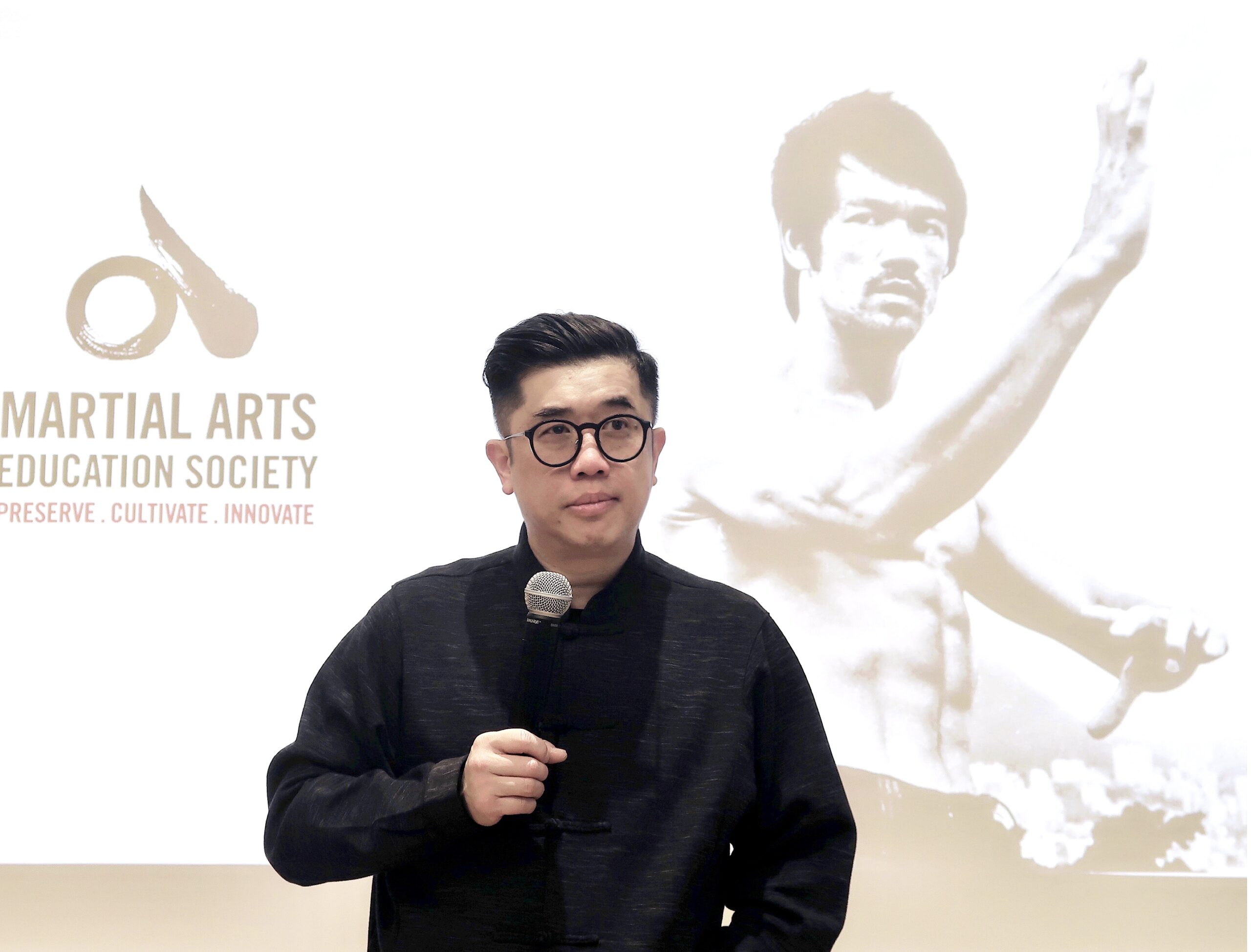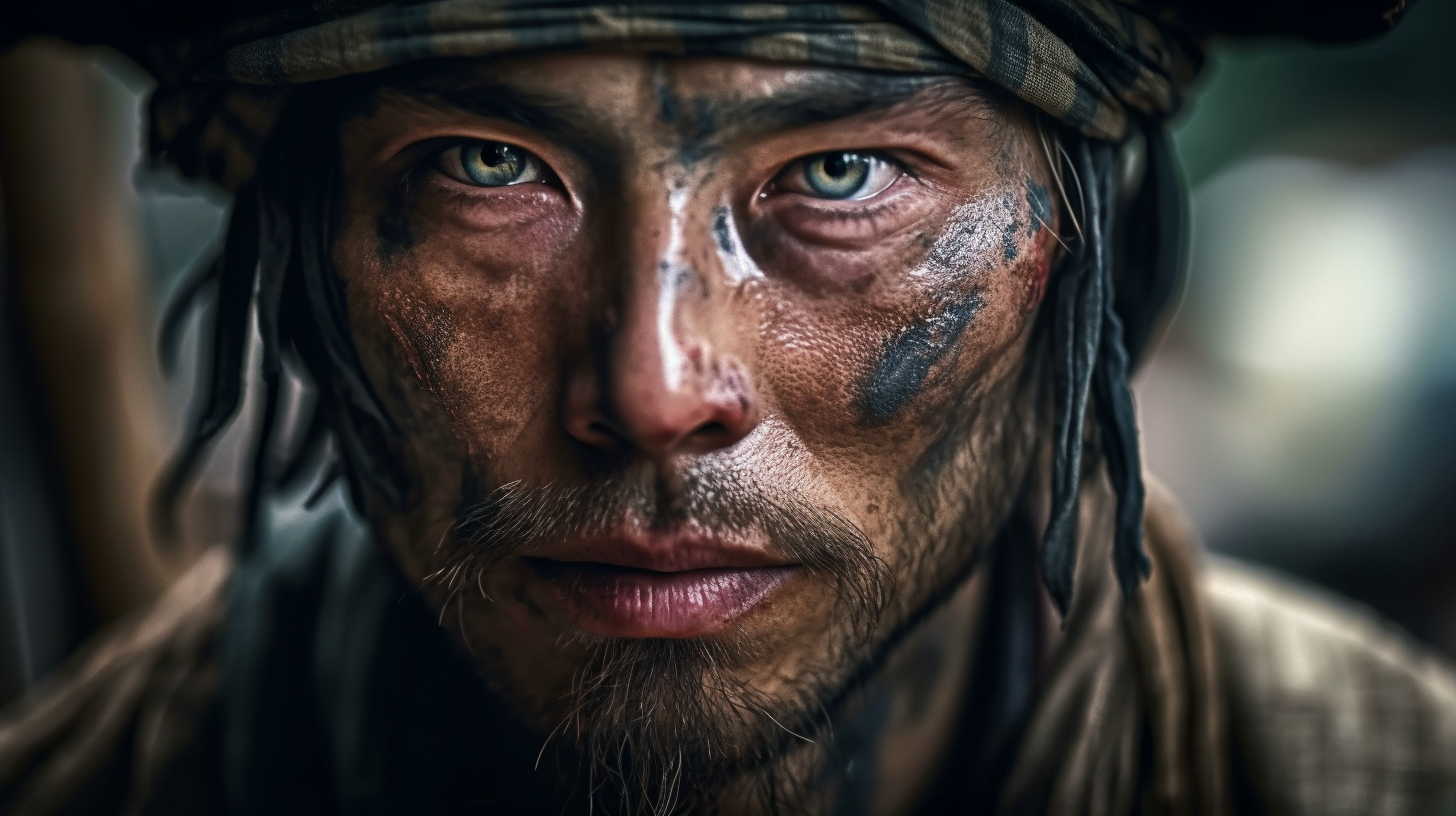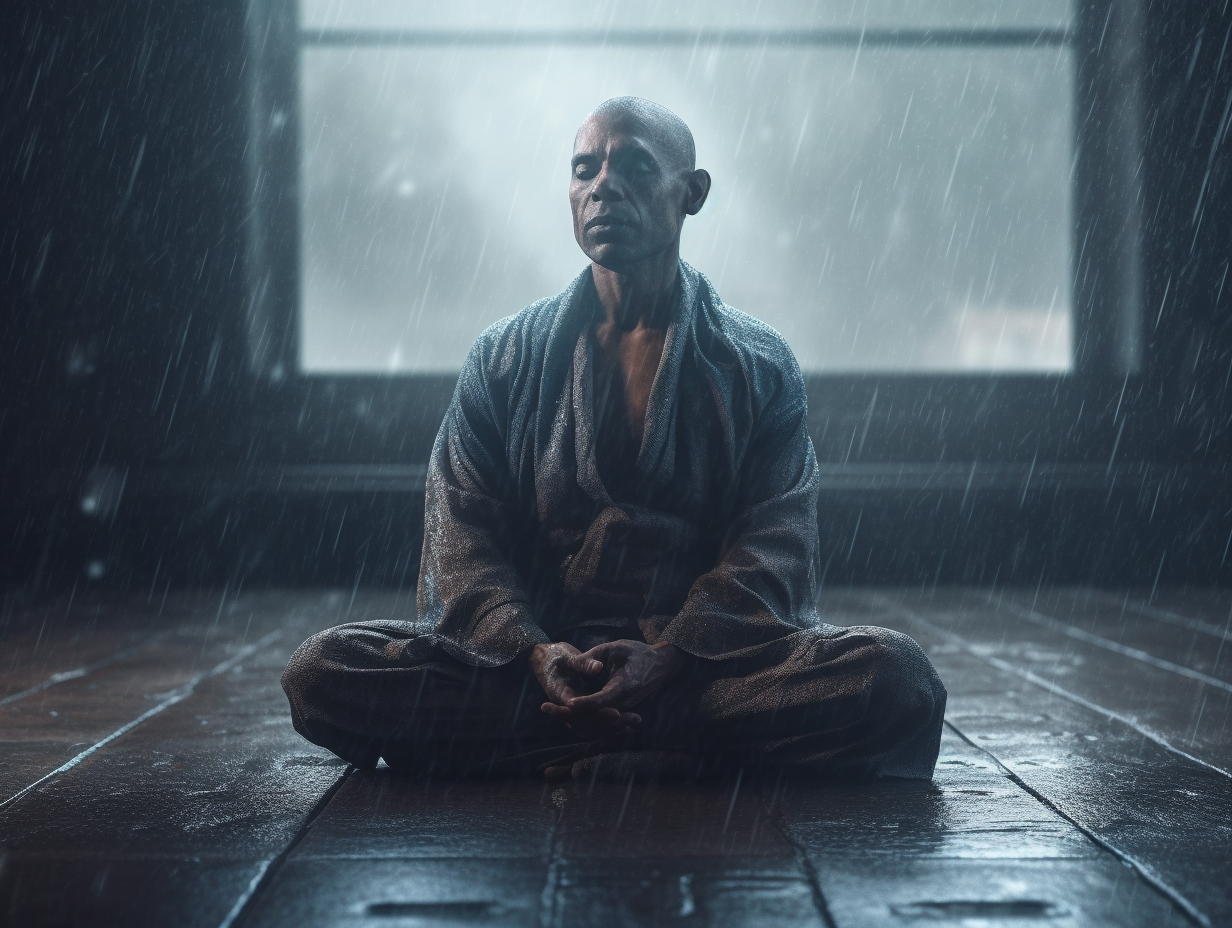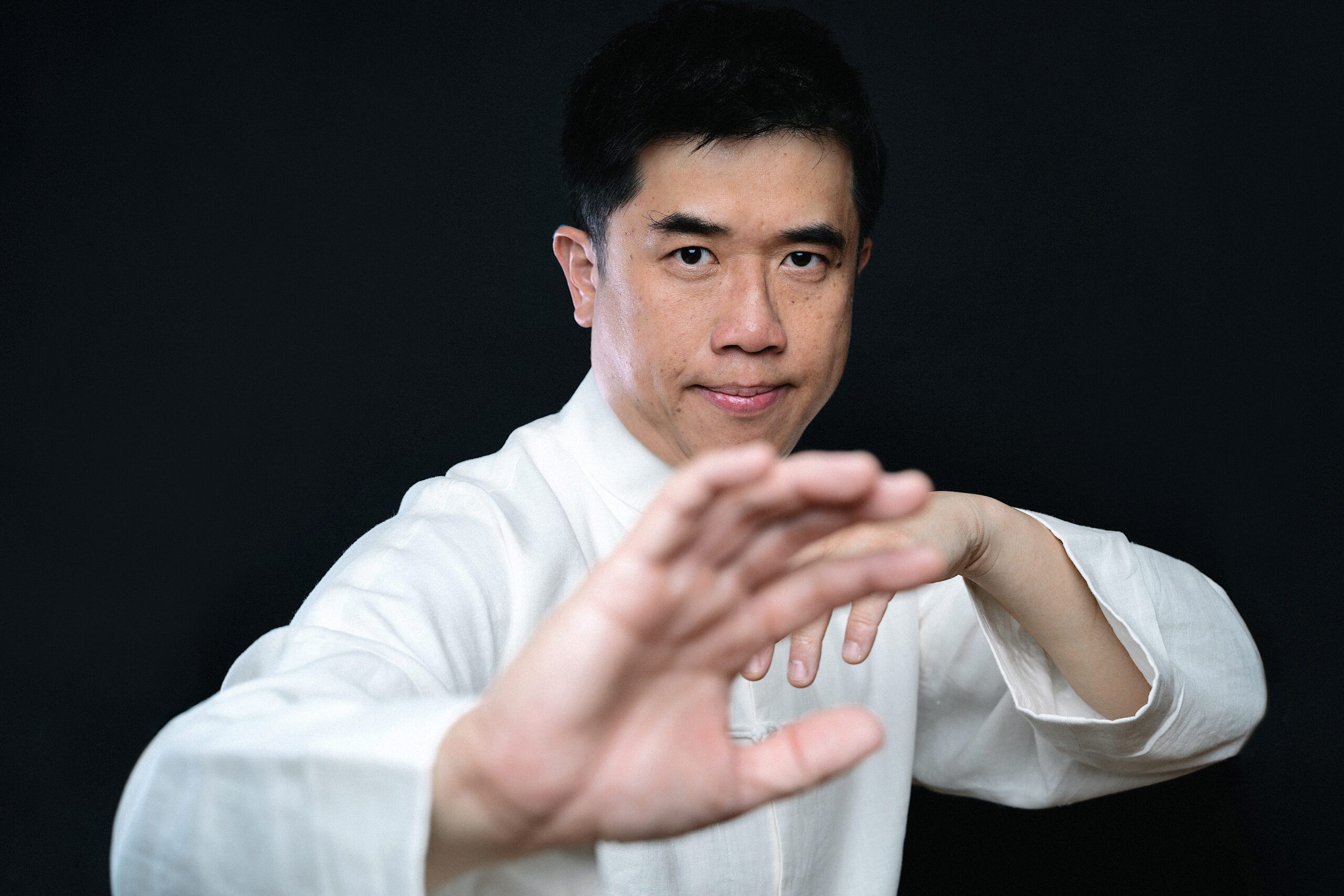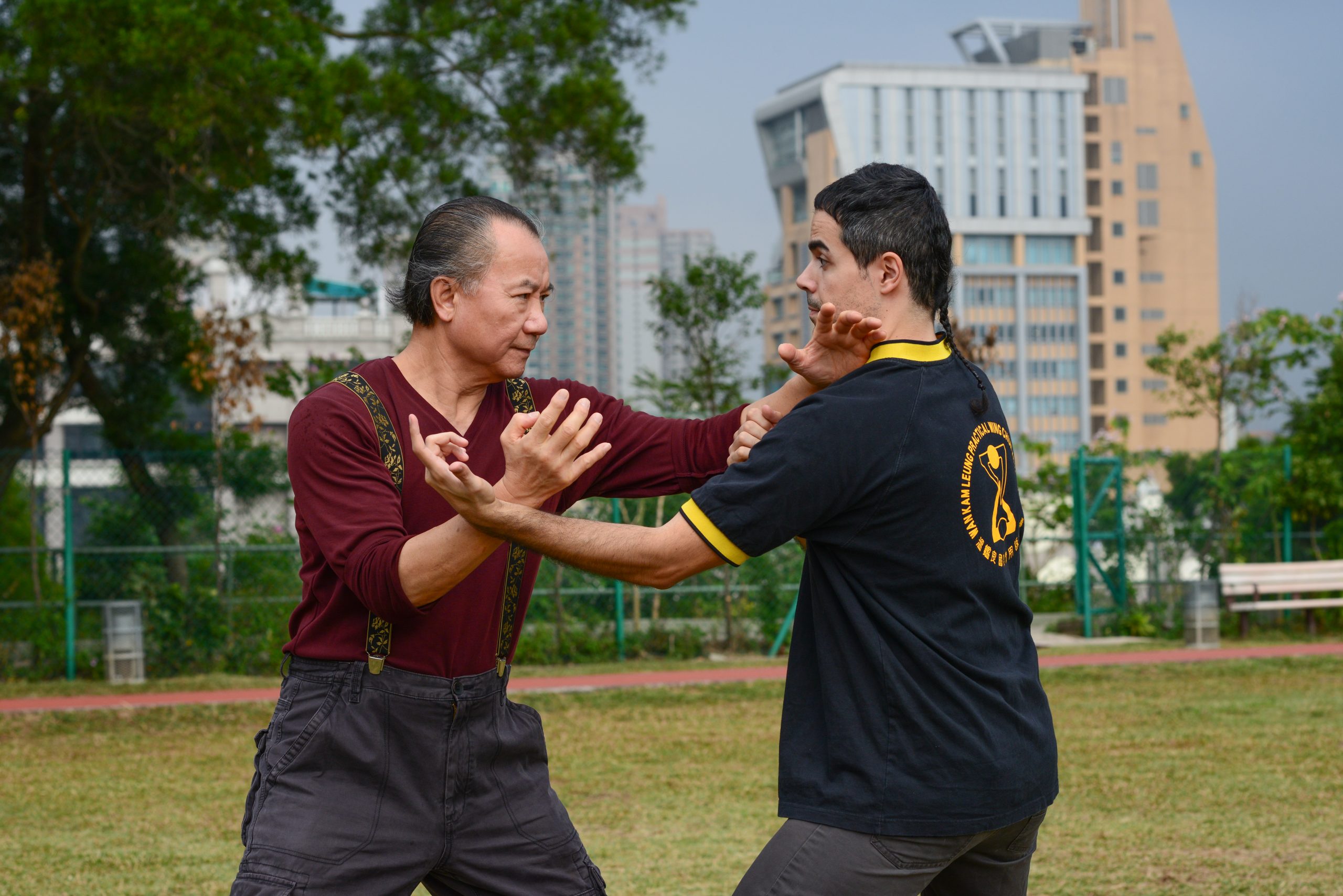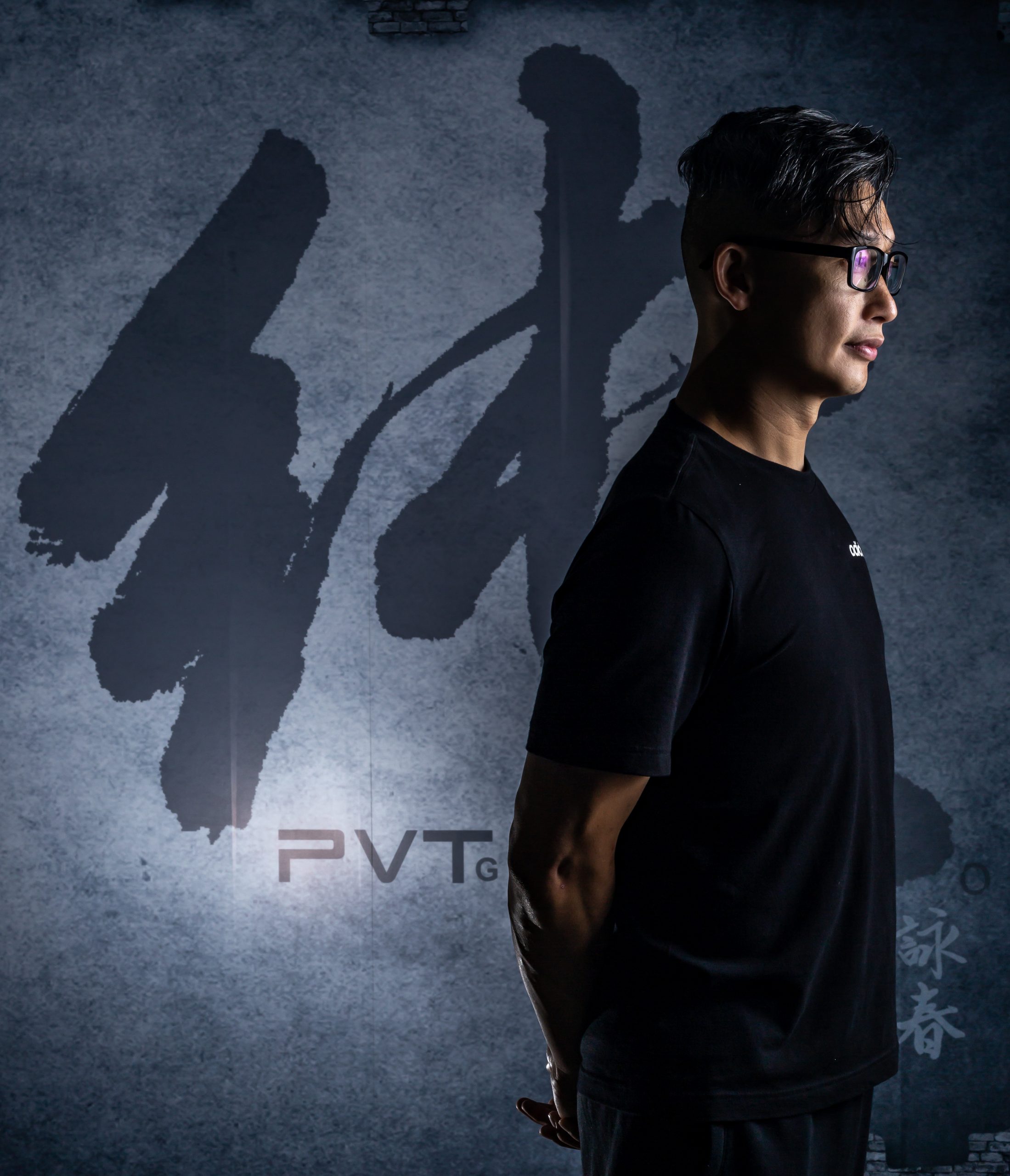When lifting a heavy box, you should bend your knees and engage your whole body to support the weight, rather than relying solely on your arms. This concept is foundational to “spiraling” in Wing Chun, where efficient movement originates from the larger muscles of the body rather than the smaller ones. “Spiraling” refers to the coordinated rotation of the arms—including pronation (inward rotation) and supination (outward rotation)—while also incorporating the extension or stretching of the arm from the fingertips to the elbow and shoulder. In Wing Chun forms, movement begins with the hands remaining relatively still, while the spiraling motion engages the back, torso, and hips. The movement should always be initiated from the core, and a benchmark for good form is that the core moves first, even if only slightly, followed by the arms. 0 Facebook 0 Twitter 0 Linkedin 0 Pinterest 0 Viber 0 Whatsapp 0 Telegram 0 Email
Tao of the Dragon
TAO OF THE DRAGON : Diving into Bruce Lee’s Water Path By William Kwok Enter the Dragon This year marks the 50th anniversary of the passing of Bruce Lee, an iconic figure in the martial arts world. As a lifelong martial arts practitioner, I was honored to be the main speaker at a Bruce Lee commemoration event celebrating Asian American Pacific Islander Heritage Month in New York. It was a truly humbling experience to have the opportunity to speak about Bruce Lee and discuss the impact of his contributions as a legendary martial artist, actor, and philosopher. He is one of my greatest inspirations, and I continue to be inspired by his teachings and philosophy every day. As an enthusiast of martial arts during my early teens, I began to appreciate Bruce Lee’s legacy beyond the silver screen. His philosophy of martial arts had a significant impact on the martial arts community, emphasizing individual expression and flexibility instead of blindly following tradition or fixed patterns. Bruce Lee, and his kung fu mentor, my Sigung, Wong Shun Leung, were undoubtedly inspirations at the beginning of my Wing Chun journey. Later, I discovered my Sifu, Wan Kam Leung, and his Practical Wing Chun system. In this way, Bruce Lee’s influence on me extended far beyond his on-screen performances and continues to shape my martial arts journey and life to this day. Empty Your Mind Bruce Lee’s impact as a martial arts legend and Hollywood icon cannot be overstated. However, it is important to remember him not just for his accomplishments in those realms but also as a philosopher and visionary who bridged the gap between Eastern and Western cultures. Bruce Lee had a unique ability to break down complex philosophical concepts into practical ideas that could be easily understood and applied to daily life. He believed that philosophy should be grounded in practical application, a fundamental aspect that he emphasized in his teachings. “Empty your mind. Be formless, shapeless, like water. You put water into a cup, it becomes the cup. You put water into a bottle, it becomes the bottle. You put it into a teapot, it becomes the teapot. Now water can flow or it can crash. Be water, my friend.” – Bruce Lee This quote has been like a guiding maxim in my life, guiding me through my personal journey. Today, as I create a short film exploring Asian immigrants’ identity, I have chosen to make the quote the guiding force of the story. During my research, I came across another quote that beautifully summarizes Bruce Lee’s philosophy: “Don’t get set into one form, adapt it and build your own, and let it grow, be like water.” This quote concisely illustrates Bruce Lee’s belief in constant evolution and adaptation. It serves as a powerful reminder to embrace change as an integral part of our lives, essential for success in martial arts and life itself. Much of Bruce Lee’s personal philosophy embodies the essence of Taoism, a Chinese philosophy and tradition rooted in living harmoniously with the natural order of the universe. By flowing with life’s ever-changing rhythms and accepting change instead of resisting it, we can achieve balance and harmony. Central to this philosophy is the concept of yin and yang, opposing yet interconnected forces present in all aspects of existence. Bruce Lee urges us to cultivate flexibility, resilience, and adaptability as we gracefully navigate life’s challenges. By letting go of fixed identities and forms, we can continuously evolve and grow, aligning ourselves with the dynamic interplay of yin and yang that shapes the world. Be Formless, Shapeless, Like Water In a civilized society, prejudices are counterproductive as they set boundaries that limit imagination and creativity for both the discriminator and the discriminated. They define a form or shape that restricts personal growth and progress. Bruce Lee countered discrimination and stereotypes not by force but by example and by showcasing his unique character and philosophical stance through the limited number of films he made. He was inclusive and openly shared his martial arts knowledge with everyone – irrespective of race and gender. He was a living example of being formless, shapeless, like water. Bruce Lee recognized the racial prejudices and stereotypes prevalent in Hollywood during his time and challenged them by portraying a powerful, self-assured, and skilled martial artist on screen. Also, it was unusual during that era for someone to believe that Chinese martial arts should be accessible to all, regardless of race, ethnicity, or gender. However, Bruce Lee held firm in his belief in unity, encouraging individuals from different backgrounds to learn from one another. He used martial arts as a medium to unite people, breaking down the barriers created by prejudice. As an actor, a martial artist, and a human being, Bruce Lee’s example of pushing past his limitations and striving for excellence is a true manifestation of his philosophy. His legacy is a powerful reminder that hard work and perseverance can help us overcome our limitations and imperfections. By recognizing his achievements and embracing our limitations, we can genuinely appreciate his accomplishments and use his example to inspire us to become the best versions of ourselves. Bruce Lee’s enduring legacy inspires individuals to honor diversity, foster equality, and strive for greatness. Water Can Flow, or It Can Crash The legacy of Bruce Lee has been a polarizing topic for many years, with different opinions emerging in recent times. Some idolize him for his revolutionary contributions to the martial arts industry, while others argue that his skills are impractical in today’s real-world combat situations. However, judging his techniques and training methods from half a century ago based on modern professional combat standards is unfair. This kind of thinking is contrary to his approach. We must focus on Bruce Lee’s philosophical stances, such as pursuing one’s true self and encouraging refinement and creation, which still apply to martial arts and other aspects of life today. Fighters of Bruce Lee’s generation were undoubtedly impressive. Muhammad
The Eye of the Tiger
Eye Spirit is a poorly understood idea, and so little is written about it that it is difficult to verbalize. In movies, we all know the moment the hero finds his courage — he develops the “Eye of the Tiger”. The eyes can play a role in demonstrating courage, both through a person’s gaze and facial expressions. When a person is feeling courageous, they may demonstrate this through a steady gaze and focused attention. But this type of gaze also plays a role in cultivating actual courage. It can be a valuable tool in fighting stress and chronic anxiety in everyday life. Overall, the eyes and facial expressions can be powerful indicators of a person’s internal state, including their level of courage and determination. By consciously controlling their gaze and facial expressions, a person can convey and cultivate a sense of strength and bravery even in the face of challenges. A focused gaze can be a helpful technique for managing anxiety in certain situations. Focusing your gaze on a specific point can help to bring your attention to the present moment and reduce distracting thoughts or worries. This technique is often used in mindfulness practices, such as meditation or yoga. So, if you are anxious or fearful on a regular basis, develop a focused gaze. Develop your “Eye of the Tiger.” 0 Facebook 0 Twitter 0 Linkedin 0 Pinterest 0 Viber 0 Whatsapp 0 Telegram 0 Email
Health Benefits of an Upright Spine
Maintaining an upright spine can have significant benefits for your overall health. A healthy spine helps support the body’s weight, protects the spinal cord, and allows proper movement and flexibility. Here are some of the ways that having an upright spine can benefit your health: Reduced risk of back pain: When you have good posture and an upright spine, you distribute your body weight evenly, reducing the pressure on your joints and muscles — this can help to prevent back pain and other musculoskeletal problems. Improved breathing and digestion: When you slouch, you compress your organs, making it harder to breathe. Bad posture can also affect your digestion. Maintaining an upright spine can help to open up your chest and abdominal cavity, improving your breathing and digestion. Increased energy and focus: Poor posture can lead to fatigue and difficulty concentrating. When you have an upright spine, you improve your blood flow and oxygenation, which can increase your energy levels and mental focus. Improved athletic performance: Good posture is essential for many sports and physical activities, including running, weightlifting, and yoga. With an upright spine, you can move more efficiently and effectively, reducing your risk of injury and improving your performance. Better mood and self-confidence: Your posture can also affect your emotions and self-confidence. Standing tall with an upright spine, you feel more confident and empowered. It can improve your overall mood and outlook on life. Maintaining an upright spine is crucial for your overall health and well-being. By improving your posture, you can reduce your risk of back pain and other musculoskeletal problems, improve your breathing and digestion, increase your energy and focus, improve your athletic performance, and boost your mood and self-confidence. 0 Facebook 0 Twitter 0 Linkedin 0 Pinterest 0 Viber 0 Whatsapp 0 Telegram 0 Email
Practical Wing Chun — The Internal Way
by Bruce Cai In the past, “Internal martial arts” were considered mysterious and esoteric. Internal martial arts are a concept, and this concept has had a profound impact on the Chinese martial arts community. In contrast, Wing Chun is a southern Chinese martial art defined as an “External Martial Art” system. However, this definition doesn’t apply to Practical Wing Chun. Practical Wing Chun is a new Wing Chun system modified by Master Wan Kam Leung. The idea of the system is based on the logic and philosophy of Chinese internal martial arts and manifested in the form of Wing Chun techniques. Internal martial arts emphasise body structure and integration of all body parts during striking. Therefore, developing the practitioners’ physical abilities is critical in internal martial arts systems. The first empty hand form in Practical Wing Chun is Siu Nim Tau. However, suppose practitioners want to truly understand and master the essence of this form — in that case, they must practice and examine every movement through the lens of internal martial arts and achieve the goal of developing the potential abilities of the body. When a practitioner embarks on their Wing Chun journey, they must first establish a correct training concept and understand that all external movements are only superficial — the subtlety behind the techniques is a test of the practitioner’s strength. The first step is determining the relationship between the shoulder, elbow and wrist(上三节 – upper three points). Unlike “elbow force” in traditional Wing Chun, Practical Wing Chun focuses on using shoulder force from the beginning. The shoulder is the largest joint in the upper body, and it is also an essential link in the transmission of the strength of the body to the fist. Wing Chun has a unique law — the elbow should always stay in the middle (centre line). This concept is vital to Practical Wing Chun. For example, when a practitioner performs a standard straight punch in Practical Wing Chun, the angle formed by the shoulders, elbows, and wrists should be 135 degrees — it should always be that angle. Why do we do this? There is a proverb in internal martial arts that with the alignment of three stars, one can move mountains — the three stars correspond to the shoulders, elbows and wrists. From the perspective of body development, when the practitioner wants to strut the shoulders, he needs to fix the elbows and wrists and ensure an angle of 135 degrees. In other words, if one arbitrarily changes this angle or straightens the arm when punching, the practitioner will use “elbow power”, thus failing to develop the shoulders. The right punch produces the proper support structure, also known as the “strut structure(撑架构)” in Chinese internal martial arts. So, does the stance of Practical Wing Chun need to be clamped? Of course, it does! The key to the Practical Wing Chun Stance is that the hips and the inside of the thigh are clamped, while the knees have no apparent internal clamping. The benefit of this kind of stance is that the strength can be better absorbed from the ground through the hips. It then reaches the shoulders through the waist and back, and finally, we apply power to the fist. When these concepts are introduced, the problem of generating force in the hips and shoulders is resolved. According to the theory of internal martial arts, there are two locks on the human body, one on the shoulders and one on the hips. If a martial arts practitioner cannot free himself from these two locks through exercise, it will be difficult for him to reach the level of the master. Once you know how to apply the “Hoi and Hup”, it is essential to understand the internal meaning hidden in the movement. “Hoi and Hup” activates the thoracic cavity by twisting the arms and shoulders, thus increasing strength. Initially, the chest is passively involved in the movement, but after a period of practice, the chest will take an active role. That is, through a change in consciousness, the chest can become the source of strength, and then the power can be applied to the hands. This consciousness transformation training is the core concept of the word “internal” in the system. Through a shift in consciousness, the body is guided to make movements. The movements are then finely tuned so that power can be issued from any desired position. As a new Wing Chun system, Practical Wing Chun perfectly integrates the elements of internal martial arts and traditional Wong Shun Leung Wing Chun, providing a new way of thinking for Wing Chun practitioners. Ω 0 Facebook 0 Twitter 0 Linkedin 0 Pinterest 0 Viber 0 Whatsapp 0 Telegram 0 Email
An Enduring Legacy: My Father’s Influence on My Wing Chun Journey
by William Kwok A Tribute to My Father’s Legacy As I reflect on my father’s legacy on the first anniversary of his passing, I remember his passion for physical education and his role in developing Hong Kong’s sports industry. My father, Mr KWOK Yuen Wah, was a remarkable Chinese calligraphy artist and a retired physical education professor at the Chinese University of Hong Kong. His perspective on diligent practice has helped me stay at the forefront of Practical Wing Chun and inspire and elevate the training of those under my guidance. Throughout his teaching career, my father inspired countless students with his knowledge and enthusiasm for physical education. During the 1980s and 1990s, he led Hong Kong’s university student-athletes to participate in international competitions worldwide, including the highly prestigious World University Games. These events not only allowed Hong Kong’s student-athletes to compete against some of the world’s best but also helped to promote the city’s sports industry and academic exchange. His leadership and guidance played a vital role in developing and promoting Hong Kong’s student sports industry. My father believed physical activity was essential for maintaining good health and developing discipline, self-confidence, and mental fortitude. He encouraged his students to pursue their passions, push their limits, and never give up on their dreams. Without my father’s support and encouragement, I would not have become the Wing Chun teacher I am today. My Journey to Practical Wing Chun When I was 13, my father introduced me to the art of Wing Chun through a summer program he taught at the university. With his guidance, I later found my Sifu, Grandmaster WAN Kam Leung, who developed the Practical Wing Chun system. In this modern interpretation of Wing Chun, the focus is on practicality and self-defence in real-world situations. This approach blends the traditional principles and values of Wing Chun with insights into movement science and body mechanics. It aligns with my father’s educational philosophy. My father’s educational philosophy emphasized integrating “Chinese traditional education as the foundation and Western education as its application.” This education should ground students in Chinese traditional culture and values, which serve as the core of their martial arts education. Students can better navigate and engage with modern society by understanding these cultures and values. They must also acquire practical knowledge of Western science and technology to meet the demands and challenges of the contemporary world. This philosophy is why my father held my Sifu’s Practical Wing Chun approach in high regard. Ever since I became a full-time martial arts educator, my father often challenged me with cutting-edge movement science theories, always encouraging me to remain open to new ideas and techniques to improve my practice. His philosophy of unwavering commitment to excellence has played a pivotal role in driving numerous breakthroughs in Hong Kong’s sports world. His influence also led me to devote myself to Practical Wing Chun practice. In addition to seeking guidance from my Sifu, I regularly consulted my father for advice on my Wing Chun practice. No matter what aspect of the training I asked about, he consistently emphasized the importance of three fundamental elements: position, timing, and speed. These seem like basic concepts but are the foundation of all physical practices and sports. The first element, position, refers to the optimal placement of one’s body during a particular movement or technique. Generating maximum power and efficiency requires proper body alignment and balance. The second element, timing, refers to the ability to execute movements precisely and accurately and anticipate and respond promptly to an opponent’s moves. Finally, speed involves not only the quick execution of movements but also the ability to control and adjust the speed of one’s movements as needed. Based on this idea, I developed five stages of San Sau (practice drills), each increasingly reliant on these three concepts, that help my students improve their techniques, increase their power and efficiency, and ultimately achieve greater success in their practice. Embracing Change and Self-Improvement As a practitioner of Practical Wing Chun, I have come to appreciate the importance of cultivating an open mind — a lesson that was instilled in me by my father and my Sifu. Embracing change is a natural process, according to the Yin-Yang theory, which I deeply respect. Tradition versus innovation is a fundamental question in the world of martial arts. Wing Chun should not remain static. I have witnessed my Sifu’s tireless efforts to evolve Wing Chun as a martial art, which attests to its potential for growth. Through Practical Wing Chun, I have honed my skills and gained insights into how open-minded individuals like my father and my Sifu approach their practice. I have learned that our practice always has room for improvement and new ideas to explore. My father taught me that we must be truthful about our limitations and strengths, always working to improve ourselves based on that understanding. Under my father’s and my Sifu’s guidance, I became aware that many martial artists become trapped by the limitations of their styles or techniques or become too focused on winning or losing. Instead, we should embrace an open-minded approach to training, where one is willing to learn from any source and adapt their skills to the situation. Being truthful also means acknowledging our fears, weaknesses, and insecurities and working to overcome them through focused practice and discipline. By being honest about our strengths and limitations, we can develop a more comprehensive and effective approach to martial arts training. Rather than simply winning or losing, we can focus on personal growth and development. The Intersection of Calligraphy and Martial Arts My father’s calligraphy was a form of art and a reflection of his character. He believed every brushstroke should be executed with precision and intention, just like we should live with purpose and meaning. He taught me that calligraphy was not just about creating beautiful characters but also about cultivating a strong sense of discipline and focus. After retiring from the university in 1993, my father channelled
Wing Chun Wifi – Do you have a weak signal?
by Jim Woodcock In all Ip Man lineages (and possibly other short bridge styles of Wing Chun), you will find the concept of keeping the elbow near the waist or the hip. Most WC styles say you should keep it roughly a fist distance away — others are not so specific and allow the elbow to be freer. There are also disagreements on how far the elbow should be from the centreline. In our system (Wong Shun Leung via Sifu Cliff Au Yeung), we hold the elbow at the point where a line drawn down from the eye-line meets the hip. (Fig 1). The distance from elbow to hip will vary according to circumstance, application, and body shape. We refer to this positional idea as Gau Bei Ga, which translates as Dog Leg Frame. This exact translation may not read well in English but think of it as the physics behind a shelf and bracket. Wikipedia describes a bracket as such: “A bracket is an architectural element: a structural or decorative member. It can be made of wood, stone, plaster, metal, or other mediums. It projects from a wall to carry weight and sometimes to “…strengthen an angle”. A bracket enables the outstretched arm to support a greater weight, a bracket will often have a third arm running diagonally between the horizontal and vertical arms, or the bracket may be a solid triangle.” (Fig 2) And this is what we are trying to achieve with this idea in Wing Chun, except that we have one pressing (literally) issue to contend with. The incoming force is from the top and also the front and sides. Once we have understood the structure behind Gau Bei Ga, we must learn to deal with frontal and sideways pressure and how to work with it, deflect it or change positions. From day one, we have many drills in our system that enhance and strengthen this skill — it is something that we not only practice and refine continuously but defines our Wing Chun. Without Gau Bei Ga, we have nothing! But just having this structure isn’t enough. We need to learn how to listen to incoming forces to interpret the signals we receive and therefore know what to do with them once we have a good connection. So how can we improve this signal? Well, the first thing is to feel what a strong signal is. Whatever method or lineage you practice, be sure that you relax (especially the forearms) and settle the elbow into its ideal position. This is the position in which you can hold structure without using the shoulder or excessive muscular strength. You should also not have to exert too much of your energy. Instead, you should lead the incoming force to the ground and use it to generate your returning force. You may be thinking, “OK. But how do I do that?” I see this kind of question often on social media platforms. The answer to that question is simple — go and ask your teacher! If they cannot answer this, they coud be using a different force system, or you need to find a new teacher! This training needs specific, hands-on teaching — no book or article can help you. You need to feel it. In my classes, I approach this by ensuring that beginners can at least hold this static position against a steady force from the front, as a bare minimum. They may need to use the rear leg first to feel the force flow from the hip through the legs and into the ground. Once they have felt this, they will have an inkling of what we mean when we talk about “force flow”. Of course, this is just an introduction. Once this idea is embedded into the student, they can begin to work on maintaining this feeling whilst moving the waist. A good analogy is that of a forklift truck (Fig 3.) You have a strong, heavy base with bent arms that can withstand pressure from all sides. You can lift objects, pull objects, and also drop them. But this analogy begins to fail as the student gets more skilful because this model is too stiff or solid and doesn’t allow for fluid and relaxed movement. But it’s a start! Another concept to introduce early on is how to hold and release force. Try to vary the force supplied to the student — from slow and heavy to fast and sharp. Each time, they should be relaxing and tensing (briefly) as they feel the incoming force. More importantly, they should be listening. By this, I mean they should feel (have an awareness of) the incoming (or lack of) forces as they ebb and flow. So, think of yourself as the mobile phone and the incoming force as the WIFI signal. You can adjust your Gau Bei Ga position to receive a better “signal”. You want that signal to go straight to the ground. When you know you have received your partner’s force signal, you can then transmit yours! Once the beginner understands this concept, they can use Taan sau and Fook sau to give and receive along the same line. Understand that there are some basics you must stick to in relation to “what you feel.” You must feel the tension in the elbow — if not, the Taan sau and Fook sau might not be in line with each other. If one partner begins pressing downwards (instead of forward), you will lose connection, allowing space for the other partner to move in. It could also mean that one partner is pushing off center, making it very easy for you to take the line. You should both listen to your elbows and make a connection together. Do you feel this? You are now online! This idea can be done simply on one side with beginners — or with both the left and right sides during Chi sau practice as each side takes turns to
Interview With Sifu Wan Kam Leung
The Birth of Practical Wing Chun Master Wan Kam Leung learned his Wing Chun under the great Wong Shun Leung. Over the last four decades, he has dedicated himself to his Art, training and researching tirelessly to evolve the original teachings passed on by his late master. Today, he is undoubtedly one of the world’s finest Wing Chun practitioners. His style utilises sharp and explosive movements designed to flank the opponent. It is a great honour for us to have him appear on the cover of our first issue, and we are grateful to him for agreeing to do this interview. We could think of no better choice to kick off our first issue. Master Wan, can you tell us about yourself? I’ve had a great passion for martial arts ever since I was very young. Before I started Wing Chun, I had already trained in several different styles. I must admit that I was not very attracted to Wing Chun in the beginning. I thought it seemed very mechanical and rigid in its movements. However, I later realized that Wing Chun wasn’t what I had initially imagined. Wing Chun is a very efficient and practical fighting system and is particularly suited for self-defence on the streets. I first met my Sifu, the late Wong Shun Leung, in the 1960s. He was just about to open his school, and I was the first student to sign up. I became very fascinated by the practicability of the system but never thought I would one day be teaching Wing Chun professionally. I promised my Sifu that I would not teach full time as long as he was still teaching. My Sifu was an inspirational figure in my life, and when he passed away so suddenly in 1997, I was very shocked and saddened. I have since been teaching Wing Chun on a full-time basis. Practical Wing Chun’s International Headquarters is located in Kowloon, on Nathan Road, and is open seven days a week. Can you tell us how you developed Practical Wing Chun? As I trained other styles before and have always had a general curiosity in all martial arts, I used to test what I learned in Wing Chun against other martial artists of differing styles. I had a lot of successful experiences but also some great defeats. Each defeat made me think about my training, and I tried to discover where my techniques were insufficient. I started to analyse each one of my techniques. In time, it evolved into Practical Wing Chun. It has been carefully modified and can no longer be considered the same style of Wing Chun that I learned. Practical Wing Chun wasn’t created overnight. The techniques have been gradually re-adjusted over time. When I call my system “practical”, I don’t mean that other Wing Chun systems are not practical. What I mean is that every movement from the empty-hand forms is practical and applicable. The reason our stance differs from traditional Wing Chun is due to the natural knee position. We still have the triangle that many traditional Wing Chun styles emphasise, but our penetrating triangle does not end so near the front of our body. It enables us to penetrate deeper with our stance when moving forward and maintaining a very natural knee and leg position. It more closely relates to the way humans walk, making it as natural as possible whilst maintaining good biomechanics. I have also found that this position is much safer against the pressure of a kick towards the knee. If the foot and knee are facing in, receiving a kick would cause terrible damage to the knee and ligaments. Whilst the foot is facing forward, a direct kick to the knee will hurt, of course, but not cause disabling damage. The main advantages are that it is more natural for stepping, balance, and changing direction, and it gives a more stable knee position to transmit force. Master Wan, Siu Nim Tao has a legendary reputation for developing great power if trained correctly. Can you elaborate on this? It is true that when you train Siu Nim Tao correctly, you can develop both Chi and power. The power that you cultivate from the form is not hard, but soft power. At the same time, you can also develop mind intent. Wing Chun only consists of 3 hand forms; each has its own characteristics. Siu Nim Tao is the first form a student learns. When practising Siu Nim Tao without moving, you practice grounding your stance, mind intent, and maintaining your balance while staying loose. The student may then practice how to apply the techniques from the form. How does Siu Nim Tao develop this power? Firstly, you need to execute the movements with as little tension as possible. You must also maintain a balanced, grounded stance. Power generation requires staying loose without tensing up. Then, you need to understand where the power is generated from when attacking or defending. Advancing actions differ from backwards movements. All this combined with breathing, body structure and angles helps with power generation. Can you give some advice to our readers on how to flank effectively? The three empty-hand forms in Wing Chun each contain offensive and defensive components, either frontally or from the side. If you are familiar with the forms, you will understand that they provide you with the necessary techniques in any given situation. First, you must become very familiar with the forms. Then you must understand the nature and details of every technique. Learn how and when to apply each one in a given situation. There are no superior techniques in Wing Chun. All can be effective if used correctly, and all can fail if used in the wrong context. Master Wan, why are there no hook punches in Wing Chun? While I believe hooks to be powerful, they do not follow one essential principle of Wing Chun: covering your centerline. Many fighters focus on hitting the opponent’s centre, but they
The Origins Of Kulo Wing Chun
Kulo Wing Chun originated in the Gu Lao Village (古勞村) in the late 1800s. Its creation is credited to the “King of Wing Chun Fist”, Dr Leung Jan 梁贊 (1826-1901), grandmaster of Ip Man. Dr Leung started his training in Wing Chun in his early 20’s, fought over 300 challenges in his life, and never lost. Dr Leung started teaching Wing Chun in Foshan/Fatshan, where he ran his successful medical practice/pharmacy. Late Grandmaster and Ip Man’s teacher, Chan Wah Shun, was one of Dr Leung’s top students. At that time, Foshan was the melting pot of Southern Style Kung Fu. Ip Man’s lineage largely came from Dr Leung’s teachings in Foshan during this time. The Foshan line of Wing Chun became very popular because of Ip Man and the late Bruce Lee. When Dr Leung retired in 1885, he returned to his ancestral home Gu Lao (Kulo) Village in Heshan. In his village, retired and free, he started teaching a different version of Wing Chun in “Sansik/Sansau” — it consisted of individual movements instead of sequential forms. Some say the Sansau were new creations — others believe they were the original method he learnt prior to the creation of forms. In any case, the Sansau are Dr Leung’s distilled teachings. While there are different Gu Lao lineages, as you practice the Gu Lao Wing Chun Sansau, you realise they are natural extensions to the mainstream Wing Chun practices. You are retracing Dr Leung Jan’s footsteps, moving forward as he did. In my opinion, it is an invaluable component to completing your Wing Chun studies. Kulo Wing Chun has none of the traditional forms such as “Siu Nim Tao” or “Chum Kiu”. What forms or exercises are found in Kulo Wing Chun instead? Different lineages of Kulo Wing Chun have a different number of Sansik/Sansau or “Points”. You may have heard of the 12-Points-System and the 40-Points-System. Our System, as taught to us by Master Leung Wun Zi of Guangzhou, comprises 22 Sansau, plus the Sansau variations and extensions. We drill these 22 Sansau repeatedly instead of structured forms. In my opinion, in the chaos of a real fight, there are no “fixed” techniques. Although the Sansau are themselves fighting techniques, they are also exercises to develop attributes that can help carry you through a real fight. For example, while 豬蹄拜佛手 Buddha Palm, 小捻手 Small Twirling Hands, and 大捻手 Large Twirling Hands can be used as actual fighting techniques, they also stretch and condition the tendons in your arms to make them elastic; in doing so increasing your 寸勁 Inch Power to be used in strikes. 日字鳳眼捶 Phoenix Eye Hammer and 十字四門虎尾捶 Tiger Tail Hammer develop your spatial management. 撐雞腳 Pheasant Kick and 跪馬捶 Bowing Horse Hammer cultivate your leg strength and hip power. Palms such as 疊掌 Stack Palms and 攔撐掌 Obstruct and Prop are designed to manage the opponent’s momentum. Each Sansau and its variations develop specific attributes. In addition to the solo Sansau practice, a big part of the Kulo 22 Sansau is the partner drills (對拆). They are cyclic movements based on the solo Sansau, repeated until the pattern becomes instinctive. The purpose is to build motor memory of the opponent’s structure and anatomy. So in a real fight, if you touch the opponent’s wrist, you know where his elbow is, then his shoulder, his head, his core, without having to look; the same way you can pick up a hot tea cup without having to look because you have been doing it repeatedly all your life. Do you believe that this emphasis away from forms makes Kulo Wing Chun easier to learn? On the contrary, no. I am a big fan of Sil Lim Tau — beginners may find it easier to learn Sil Lim Tau first. Although, one can jump straight into the Sansau if the student is prepared to put in the hard yards. For students who already have experience in Sil Lim Tau, the Sansau break down the limits. They provide the freedom to fully utilise the structure you have built up in your Wing Chun training. My suspicion is that when Dr Leung Jan started teaching the Sansau method, he was more interested in incorporating all his fighting experience into the system than focusing on the mundane; the same way we often see top Kung Fu masters breaking their own rules. Perhaps he assumed the students already knew the basic Wing Chun structures. Kulo Wing Chun is known for its side body methods (Pin Sun Ma – Side Body Horse). Can you explain how this method works? Actually, side body methods exist in every Wing Chun style, although they are not emphasised as much. Of course, in Kulo Wing Chun, we embrace the Side Body method. No matter what Wing Chun we do, there are three ways to face an opponent: 1. 朝面追形 – Square On, Chasing Structure: this is the most commonly seen Wing Chun Method. You chase the opponent’s structure to face him square on. 2. 迎面而轉 – Rotating with the opponent to face him: As your opponent turns, you turn in the same direction as him. If he rotates clockwise, you turn clockwise. If he rotates anti-clockwise, you turn anti-clockwise as well. In doing so, you are not exposing your weakness and continue to face him. 3. 逆面管勢 – Counter-Facing and Controlling Momentum: this is a counter-move to the opponent’s direction in order to enter his blind side and control his structure. When we enter the opponent’s blind side, we reduce their ability to generate power. Their defence and attack are compromised. While this method exists in almost all Wing Chun lineages, we place particular emphasis on this. Hence we are sometimes called the Side-Body Method. Can you explain what type of partner practice you use in Kulo Wing Chun? How long is a piece of string? Haha. My teacher, Master Leung Wun Zi of Guangzhou, outlined 42 partner drills, but it is limited only by your
Interview with Sifu Jerry Yeung
Sifu Yeung, please tell us a little bit about yourself. Was Wong Shun Leung your first Sifu, and how did you meet him? I started learning Ving Tsun when I was 14. I went to one of the SiHings school, who opened the Ving Tsun school after my Sifu passed away. I got a chance to continue the training there and started teaching and training with some of the students in the school. In my thirties, I started my own school and taught Ving Tsun part-time. It is now almost 10 years ago. I quit my job in a trading company and directed my energy into running the Ving Tsun school full-time, teaching people to spread the Ving Tsun skills and experiences I had learnt throughout the years. Sifu Wong Shun Leung is my first and only Sifu in Ving Tsun. I was lucky to meet him in my early years. He was not only teaching me Ving Tsun, but also guided and gave me a direction for my life. I wasn’t doing well in my studies at school and he let me know that besides the academics, I could also build myself up and my career, through kung fu. I felt that he was a great man, he had amazing achievements in Ving Tsun and was recognized as a great fighter. I never thought I could walk the same path as he did. I am not saying I am a great fighter now, but I have built my career with the Kung Fu I like so much. In the 80s, fighting in school was quite common. My uncle was learning Ving Tsun at that time, and he took me to Sifu Wong Shun Leung after I lost a fight at school. My uncle asked me whether I liked Ving Tsun after the first trial class, and of course I said yes, because I knew he liked this kung fu very much. He also paid my Ving Tsun class fee, so I had no excuse for not going. Tell us about “Pure Ving Tsun” (PVT). How did it start and for what purpose? In my early 30’s, I suddenly thought “what should my career be in the future? Where should I go? What do I want to achieve?” Coincidently, I saw that some kung fu brothers started teaching in the parks or even opening their own schools. I asked myself: “Why can’t I do the same? Will I be able to teach?” I thought it would be great if I could teach, help people understand kung fu and be able to fight. This would be a great achievement, being able to share the skills I have. I realized I like teaching people very much, but it is not easy. I started thinking about having my own class for Ving Tsun. Since I was not a famous Ving Tsun practitioner and no one knew me, I asked my friends and colleagues to learn from me and try. In order to promote my class, I uploaded a Gor Sau video online and had to think of a name for it. I wanted to only talk about Ving Tsun. Ving Tsun was the only element in it – nothing else. Thus I used the word “Pure”, and the name of the video is “Pure Ving Tsun”. Many teachers today are mixing Wing Chun with other Martial Arts. Pure Ving Tsun does not. What are the benefits and disadvantages of both approaches? I believe different martial arts have their own strengths and are for different purposes. Using distance as an example, kicking, punching, and grappling represent 3 different distances. It is not necessary to master all 3 distances, but you need to train yourself like a professional in one of these. Furthermore, the concepts behind each martial art can be different or even contradict each other. Thus if you want to mix it, you have to know and understand each martial art very deeply. What are the advantages of training in Wing Chun? Can it improve people’s performance in other areas of their lives, such as work or relationships? There are many concepts that can be applied to our daily lives, and thus in 2017/18 we had the theme “Yǐ quán rù zhé” (以拳入哲), which says “Through The Punch, into Philosophy”. I want to share that learning this Kung Fu can bring philosophy into your life – and how to apply it. It basically changes the mind set (makes you think in a different way). It is a problem-solving technique. For example, the concept of forward and backward stepping teaches you not to always move forward. Stepping backward can give you another point of view and helps you to build a different vision. You have fought in various competitions. What was that like, and do you recommend Wing Chun practitioners to do the same? First of all, I need to tell readers that I have fought in Sanda, Boxing and Thai Boxing Competitions, not Ving Tsun competitions. If you learn Ving Tsun, and want to participate in other martial art competitions, it is difficult and dangerous, as the standards and requirements are completely different among different martial arts. If you are a Chinese cuisine cook and entered a French cuisine competition, what would that look like? When you enter any competition, you need to have a clear understanding of what that martial art is about. You will need to train with those skill sets instead of using Ving Tsun drills. You must be able to extract and apply the concepts to it. You need to have a very clear understanding of what you have learnt in Ving Tsun. For example, if you enter MMA competitions, you are following their rules, which might contradict your own kung fu. Thus you fall into your opponent’s strengths and they will have advantages under those conditions. Tell us about Kung Fu Quest. How did you get involved in it? Philip Ng, who acted as Bruce Lee in the 2017 film Birth of the Dragon is my SiDai. We learnt Ving Tsun together in the 90s. I was invited to take part in the

